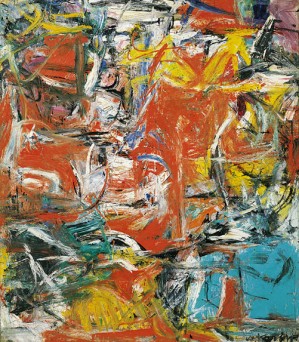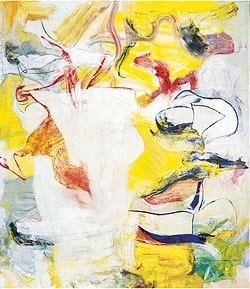Pop's Pop
John Haberin New York City
Willem de Kooning: An American Master
Call it yet another paradox of the art market. Museums take more and more pains to pull in the crowds, while galleries do their best to look exclusive. And few manage to look as imposing as Gagosian's Chelsea space.
Taking in the career of Willem de Kooning hardly seems any easier. No wonder I could not bring myself to breach that wall into Gagosian's central gallery. Instead, I turned right, to the mundane bustle of a smaller space, shared by the gallery office. 
And there, somehow, de Kooning had the paradox down all along. The handful of small drawings and oils from the 1960s looked as layered as Old Masters, as flashy as "action painting," and as rigorously abstract as one expects for Abstract Expressionism.
Or at least they did until their fragments of shocking pink gathered into flesh. It was okay to smile again. Again and again, amid decades of changing styles and subjects, de Kooning lends his formal, gestural abstraction the charge, wit, and sly vulgarity of Pop Art and Postmodernism.
Fire sale
The art scene has definitely outgrown de Kooning's frugal origins. Museums hold open house for the whole neighborhood, while galleries beyond Chelsea make the in crowd ferret them out. Museums play down their grand, century-old entrances, while galleries remake themselves as temples of art.
It may sound like the artist's early years after all (and more recently MoMA has had a fuller de Kooning retrospective). Back then, it was houses of worship just starting to welcome the shopping-mall crowd, while banks were trying to look like gated temples rather than computer terminals. Back then, too, de Kooning was at one moment helping to define American formalism, at the next trading riffs with Pop Art as casually as if he belonged to the next generation.
Gagosian definitely thrusts the problem in one's face. Its supposed retrospective acts at once suspect and magisterial, like a blowhard who almost makes one forget he earned his boast. It never wants one to forget that, till 1997, the old guy with Alzheimer's stood as America's greatest living painter. He would have turned 100 on April 24, the very day that the show opened. It could not have been a surprise party.
The retrospective has only thirty-five paintings, biased toward a central halls of relatively later work, when naturally more is available to the market. It draws on significant loans, such as a small, dense, black tiling from Princeton University and a large, colorful, messy abstraction from the Guggenheim. (Another great monochrome abstraction is coming to the Met, in the Muriel Kallis Newman bequest.) These, too, however, must stop short of the textbook de Koonings. One could easily deride it all, as an entrepreneur's usual use of loans to lend stature to a fire sale. Only here the works truly are on fire.
The painter made himself difficult to pin down. His career thrived on the claims for "action painting" by Harold Rosenberg, just when Clement Greenberg in his formalism, Jackson Pollock in his dance around the edge of the canvas, and Ad Reinhardt in his refusal were beginning to dominate the critical debate. He painted figures as fleshy and threatening as Pablo Picasso's women, just when history was starting to worry about the lost perspective of real women—whether Lee Krasner and Joan Mitchell or the ones put on canvas for the male gaze. He loosened up, under the influence of his late friend Arshile Gorky, only to lose his grip entirely to neurodegenerative disease.
The exhibition itself shows an artist changing style faster than one can keep up. Already in its first, small room—in the opposite direction from the office—one has the black paintings, the abstractions largely in primary colors, and the women. Then one has the incorporation of landscapes and natural tones, right alongside the discovery of acid hues out of industrial processing. The nudes peep out again, so casually, in the back office. Then the canvases expand again, first densely and then finally with sweeping areas of black and quieter colors.
"All over" the map
Along the way, de Kooning seems to have anticipated every criticism and then some. Want a formalist? The Princeton work compresses the craggiest of American landscapes and the bleakest emotions into the space of Analytic Cubism. His black paintings bring Modernism from the café society of Paris into the dark, empty edges of New York. They have outwalked the farthest city light.
 As in the Guggenheim's 1955 Composition, de Kooning can use just a hint of symmetry or primary color to organize the most chaotic "all-over" painting. However, the organization, he insists, holds for that split second of visual awareness. The dominant red of Composition starts in a near square, echoed in framing lines on all four edge, before sending a burst down through the center of the canvas. The work, like many a Jackson Pollock, uses both traditional oil paint and enamel. However, it also incorporates charcoal, like a casual sketch—or the charred remains of itself.
As in the Guggenheim's 1955 Composition, de Kooning can use just a hint of symmetry or primary color to organize the most chaotic "all-over" painting. However, the organization, he insists, holds for that split second of visual awareness. The dominant red of Composition starts in a near square, echoed in framing lines on all four edge, before sending a burst down through the center of the canvas. The work, like many a Jackson Pollock, uses both traditional oil paint and enamel. However, it also incorporates charcoal, like a casual sketch—or the charred remains of itself.
Want a feminist? de Kooning keeps the quirky independence of Picasso's women, with their flair for staring right back. At the same time, he infuses them with a palpable joy denied to Picasso's universe—not to mention art history's demure goddesses and lovers. Some grin, more for the camera than for a propositioning male. One, in a 1944 painting at the Met and not in the exhibition, plumps herself down amid what look like knock-offs of early Modernism. With her red nails, she seems to have hurried from the "beauty parlor," as they said back then, to an opening, as well as in and out of de Kooning's id.
Picasso paints women as angry and sad, lovers and whores, the subject of his gaze and staring right back, the projection of his impulses and an art that dissolves personality into masks. Chaim Soutine, compared to de Kooning in a show several years ago, moved between sides of beef and portraiture, like from one meat market to another. His women have instead the vulgar familiarity of the suburbs. If they rest along the time line between Picasso and Georg Baselitz, they also lie between Edward Hopper and Eric Fischl.
One can imagine the good-natured artist welcoming Cecily Brown and her appropriation, just as he happily gave the still little-known Robert Rauschenberg the drawings that became Erased de Kooning. Sure, he seems to say, let them erase the pretensions of my generation. Maybe they'll teach me enough to keep my art alive.
And they did. The show could not substitute for a proper retrospective or a concentrated examination of any one aspect of de Kooning's career. The white paintings, such as Excavation at the Art Institute of Chicago, put in an appearance—but only in the catalog, in reproduction. Still, by focusing on the 1970s, while placing it against an earlier context, the exhibition taught me to see the later works differently. I could understand them not only as a return to Gorky but also as a savvy response to younger artists.
Throwing formalism a curve
Obviously one has the debt to his rivalry with Pollock—the play with edges and symmetry, the frontal, layered images that invite and exclude the eye, the house paint, the spatters and drips. Still, he stayed close to Gorky personally and as an artist, right down to Gorky's bitter end. Mark Rothko, who studied with Gorky, learned technique, especially the slow spread of saturated color. Perhaps de Kooning learned more of an eye.
Gorky obsessed over Picasso, who lurks behind de Kooning's shard paintings and his women. Gorky kept returning to landscape themes, loosely based on his childhood in Armenia. Although de Kooning does, too, he seems to prefer the piers of New York City and Long Island to his native Rotterdam. Most of all, Gorky's best compositions have those fluid curves. One can see them all over those de Koonings of the 1970s, before even those curves fade out into softer work of the 1980s.
However, perhaps the 1970s' abstractions have a closer interchange with other art as well. The curves flatten out like billboards, and every one looks larger than life. They look like handmade hand-me-downs, quite as much as an early Andy Warhol or James Rosenquist, much less late Warhol. They represent their own making as insistently as a Roy Lichtenstein Brushstroke. They may also look back much further to another ancestor of Pop Art, Stuart Davis, who introduced a pack of Lucky Strikes into a Cubist landscape. Looking back, de Kooning named Gorky, Davis, and John Graham as his American mentors—or as he put it, "The Three Musketeers"—and each in turn leads to Picasso's influence.
One can look back, too, to de Kooning's early years, when he had first to choose a career as a painter and then support himself as one. Both stages exposed him to an alternative, in commercial art. In Rotterdam, he received some academic training, like Adolph Gottlieb in America, but he also worked on decorative designs for a commercial firm. In America, he created shoe-store displays, lost a competition for a Ford logo, and as late as 1942 drew a tobacco ad that appeared in Life magazine. By then de Kooning saw the alternatives as mutually exclusive, and he wanted his commercial illustrations destroyed, because "they come back to haunt you." Perhaps they did.
Others before have seen de Kooning as at home in the 1960s and 1970s. Three years ago, a show paired him with John Chamberlain and his crushed automobiles. Here, however, one can see a side of that decade that ground Modernism to pulp fiction rather than to pulp. The de Kooning women sometimes embarrassed advocates of Abstract Expressionism, but they had to influence Pop Art.
I left thinking of Gagosian's last room as returning the favor. Historians have seen "the triumph of American art" as Modernism's startling second incarnation—or its last stand. Critics have placed the end of formalism anywhere from Rauschenberg's erasure and Minimalism's "theater" to the diversity of the late 1980s or today. A de Kooning birthday party serves as a healthy reminder of the mess his generation already made. Was Abstract Expressionism also Pop's pop?

Willem de Kooning's hundredth anniversary show ran at Gagosian through June 19, 2004. For background on the artist's early career choices, I draw on de Kooning: An American Master, by Mark Stevens and Annalyn Swan (Knopf, 2005). A related article surveys his career in conjunction with the 2012 de Kooning retrospective.




